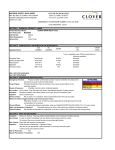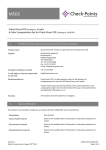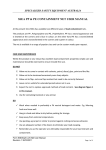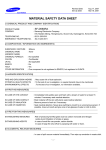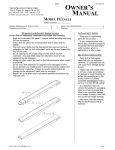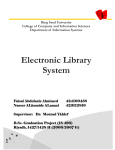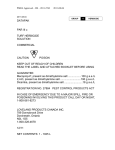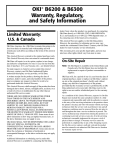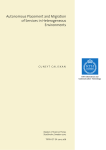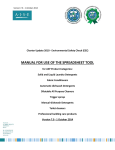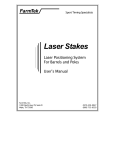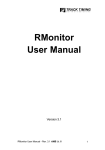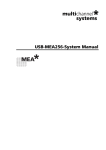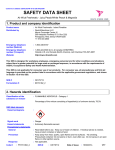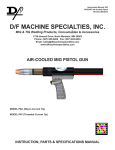Download BCE20-E40 Clover MSDS Sheet
Transcript
MATERIAL SAFETY DATA SHEET MAY BE USED TO COMPLY WITH OSHA'S HAZARD COMMUNICATION STANDARD 29CRF 1910.1200 DATE PREPARED: 7/23/2010 SIGNATURE OF PREPARER (OPTIONAL) SECTION 1 CHEMICAL PRODUCT / NAME CPT-02 ELI75052 Product/Chemical Name: Product No: CAS Number: Other Designations: General Use: Distributor: S.P. Richards Company 6300 Highlands Parkway Smyrna, GA 30082 866-638-9227 Mixture N/A Laser Printer Manufacturer/Supplier: West Point Products 250 W. Wylie Ave. Washington, PA 15301 SECTION 2 COMPOSITION / INFORMATION ON INGREDIENTS Ingredient Name: CAS NUMBER EU % REBMUN OSHA PEL ACGIH TLV OTHER LIMITS Toner is regulated under OSHA as particulate not otherwise regulated: Styrene-Acrylate resin Magnetite Polyolefin Metal Complex Silica 25036-16-2 1309-38-2 Trade Secret Trade Secret 67762-90-7 30-45 45-55 1-5 1-5 1-2 NDA = NO DATA AVAILABLE N/A = NOT APPLICABLE SECTION 3 HAZARDOUS IDENTIFICATION Inhalation Primary Entry Routes: N/A Target Organs: Acute Effects: N/A Inhalation: Slight irritation of respiratory tract. Dust may cause irritation by mechanical abrasion. Eye: NFPA/HMIS 1 1 1 - HEALTH FLAMMABIL REACTIVITY PPE (Sec.8) Skin: Slight irritation. None known. Ingestion: N/A Carcinogenicity: Accumulation of dust in the respiratory system Medical Conditions Aggravated By Long-Term Exposure: may cause congestion. If these materials are used in a manner that could generate airborne particles (dust), it is recommended that Chronic Effects: the dust may be treated as a NUISANCE PARTICULATE according to the American Conference of Government Industrial Hygienists (ACGIH)(TLV=10mg/m3). SECTION 4 FIRST AID MEASURES Remove to fresh air. Treat any irritation symptomatically. Call a physician if condition persists. Inhalation: Eye Contact: In case of contact immediately flush with plenty of low pressure water for at least 15 minutes. Remove any contact lenses to ensure thorough flushing. Skin Contact: Wash well with soap and running water. N/A Ingestion: After first aid, get appropriate in-plant paramedic or community medical support if serious signs and symptoms persist. Note to Physicians: N/A N/A Special Precautions / Procedures: SECTION 5 FIRE FIGHTING MEASURES Flash Point: N/A Flash Point Method: N/A Burning Rate: N/A Auto Ignition Temperature: Not Determined LEL: N/A UEL: N/A Flammability Classification: 1 Slight (HMIS, NFPA) Extinguishing Media: Water spray, dry chemical, foam, carbon dioxide, or halon type extinguishers. Unusual Fire of Explosion Hazards: May form flammable dust-air mixture. Hazardous Combustion Products: Carbon monoxide, carbon dioxide, nitrogen oxide and smoke. Under certain conditions some aliphatic aldehydes and carboxylic acids may form. Fire-Fighting Instructions: Do not release runoff from fire controls methods to sewers or waterways. Fire-Fighting Equipment: Because fire may produce toxic thermal decomposition products, wear a self-contained breathing apparatus (SCBA) with full facepiece operated in pressure-demand or positive-pressure mode. SECTION 6 ACCIDENTAL RELEASE MEASURES Spill / Leak Procedures: N/A Small Spills: Scoop into a container for disposal, suction up remaining material with a high efficiency vacuum cleaner. Large Spills: Scoop into a container for disposal, suction up remaining material with a high efficiency vacuum cleaner. Containment: For large spills, avoid suspending particles, collect for later disposal. Do not release into sewers or waterways. Cleanup: No special requirements. Regulatory Requirement: N/A SECTION 7 HANDLING AND STORAGE Handling Precautions: Storage Requirements: Regulatory Requirement: Keep containers closed at all times. Avoid creating dust. Keep away from ignition sources. Store in a cool, dry location. N/A SECTION 8 EXPOSURE CONTROLS / PERSONAL PROTECTION Engineering Controls: Ventilation: Provide general or local exhaust ventilation systems to maintain airborne concentrations below OSHA PELs (sec.2). Local exhaust ventilation is preferred because it prevents contaminant dispersion into the work area by controlling it at its source. Administrative Controls: Respiratory Protection: Seek professional advise prior to respirator selection and use. Follow OSHA respirator regulations (29 CFR 1910.134) and, if necessary, wear a MSHA/NIOSH-approved respirator. Select respirator based on its suitability to provide adequate worker protection for given working conditions, level of airborne contamination, and presence of sufficient oxygen. For emergency or nonroutine operation (cleaning spills, reactor vessels, or storage tanks), wear an SCBA. Warning! Air-purified respirators do not protect workers in oxygen-deficient atmosheres. Protective Clothing/Equipment: Wear chemically protective gloves, boots, aprons, and gauntlets to prevent prolonged or repeated skin contact. Wear protective eyeglasses or chemical safety goggles, per OSHA eye and face protection regulations (29CFR 1910.133). Contact lenses are not eye protective devices. Appropriate protection must be worn instead of, or in conjunction with contact lenses. Safety Stations: Make emergency eyewash stations and washing facilities available in work area. Contaminated Equipment: Separate contaminated work clothing from street clothes. Launder before re-use. Remove this material from your shoes and clean personal protective equipment. Comments: Never eat, drink, or smoke in works areas. Practice good personal hygiene after using this material, especially before eating, drinking, using the toilet, or applying cosmetics. SECTION 9 PHYSICAL AND CHEMICAL PROPERTIES Physical State: Appearance and Odor: Odor Threshold: Vapor Pressure: Vapor Density (Air=1): Formula Weight: Density: Specific Gravity: pH: Black, free flowing powder, slight odor N/A N/A Heavier than air. N/A N/A (H2O)=1, at 4°C): 1.0-1.5 N/A Water Solubility: Other Solubilities: Boiling Point: Freezing/Melting Point: Viscosity: Refractive Index: Surface Tension: % Volatile: Evaporation Rate: Negligible N/A N/A 100-150 C (Softening Point) N/A N/A N/A N/A N/A SECTION 10 STABILITY AND REACTIVITY Stability: Stable Polymerization: N/A Chemical Incompatibilities: N/A Conditions to Avoid: None Hazardous Decomposition Products: CO and CO2 and other decomposition products when burned SECTION 11 TOXICOLOGICAL INFORMATION Eye Effects: N/A Toxicity Data:* Skin Effects: N/A Acute Inhalation Effects: Acute Oral Effects: Chronic Effects: Carcinogenicity: N/A N/A N/A N/A Mutagenicity: Ames Test Negative Teratogenicity: (Estimated from the results of testing the constituent components) N/A *See NIOSH, RTECS for additional toxicity data. SECTION 12 ECOLOGICAL INFORMATION Ecotoxicity: N/A Environmental Fate: N/A Environmental Degradation: Soil Absorption / Mobility: N/A N/A SECTION 13 DISPOSAL CONSIDERATIONS Disposal: Waste material may be incinerated / or recycled for its Iron Oxide under conditions which meet all federal, state, and local environmental regulations. Disposal Regulatory Requirements: N/A Container Cleaning and Disposal: N/A SECTION 14 TRANSPORT INFORMATION DOT Transportation Data (49 CFR 172.101): Shipping Name: Shipping Symbol: Hazard Class: ID No: Packing Group: Label: Special Provisions: N/A N/A N/A N/A N/A N/A N/A Not specifically listed. Packaging Authorizations a) Exceptions: N/A b) Non-bulk Packaging: N/A c) Bulk Packaging: N/A Quantity Limitations a) Passenger, Aircraft, or Railcar: N/A Vessel Stowage Requirements a) Vessel Stowage: N/A b) Other: N/A SECTION 15 REGULATORY INFORMATION EPA Regulations: RCRA Hazardous Waste Number: Not listed (40 CFR 261.33) RCRA Hazardous Waste Classification: (40 CFR 261): Not classified CERCLA Hazardous Substance (40 CFR 302.4) listed unlisted specific per RCRA, sec. 3001; CWA sec.311 (b)(4); CWA, Sec. 307(a),CAA,Sec.112 CERCLA Reportable Quantity(RQ), Not listed SARA 311/312 Codes: N/A SARA Toxic Chemical (40 CFR 372.65): Not listed SARA EHS (Extremely Hazardous Substance) (40CFR 355): Not listed, Threshold Planning Quantity (TPQ) OSHA Regulations: Air Containment (29 CFR 1910.1000< Table Z-1-A): Particulates not otherwise regulated. State Regulations: Check your states regulations that may specifically list copy machine toner. SECTION 16 OTHER INFORMATION Prepared By: N/A Revision Notes: N/A Additional Hazard Rating System: N/A THIS INFORMATION IN THIS MSDS WAS OBTAINED FROM SOURCES WHICH WE BELIEVE ARE RELIABLE. HOWEVER, THE INFORMATION IS PROVIDED WITHOUT ANY WARRANTY EXPRESS OR IMPLIED, REGARDLESS IT'S CORRECTNESS. THE CONDITIONS OR METHODS OF HANDLING, STORAGE, USE AND DISPOSAL OF THE PRODUCT ARE BEYOND OUR CONTROL, AND MAY BE BEYOND OUR KNOWLEDGE. FOR THIS AND OTHER REASONS, WE DO NOT ASSUME RESPONSIBILITY AND EXPRESSLY DISCLAIM LIABILITY FOR LOSS, DAMAGE OR EXPENSE ARISING OUT OF OR IN ANY WAY CONNECTED WITH THE HANDLING, STORAGE, USE OR DISPOSAL OF THE PRODUCT.




